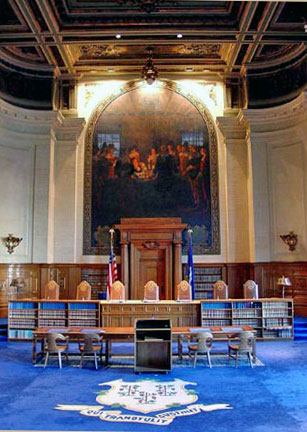Between September and June of each year, the Supreme Court hears oral arguments on pending cases in eight two-week terms in the Supreme Court courtroom located at 231 Capitol Avenue in Hartford. Oral arguments are open to the public and you are invited to attend.
The proceedings in the Supreme Court differ from the trial court proceedings in three important respects: First, this court does not hear the testimony of witnesses. Instead, it hears the arguments of lawyers for each party, who have filed written briefs beforehand in which they have described the case to the court.
Second, this court does not decide questions of fact. Instead, it decides issues of law, such as the interpretation of a statute or the constitutionality of the procedures used in presenting evidence at trial.
Finally, this court does not decide a case immediately after the proceedings. Rather, after each side has had the opportunity to present its case to the court in a half-hour oral argument, the court takes the case under advisement and delivers its judgment within a few months.
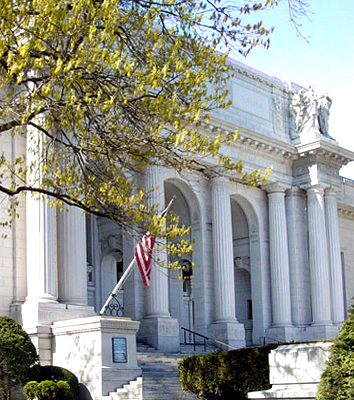
Prior to the creation of the Supreme Court in 1784, the power to review lower court rulings was vested in the General Assembly, which determined appeals by examining trial court records. Even after its creation, the Supreme Court was not completely independent of the executive and legislative branches, since its members included the Lieutenant Governor, members of the Council (or upper chamber of the General Assembly), and, in 1794, the Governor.
In 1806, the number of Superior Court judges was increased from five to nine and those judges, sitting together, constituted the Supreme Court, replacing the Governor, Lieutenant Governor and Council Members. The General Assembly, however, retained the power to overturn the court’s rulings. Twelve years later, in 1818, the Connecticut Constitution established an independent judiciary, with the Supreme Court of Errors as the state’s highest court. (The words “of Errors” were deleted in 1965). The creation of an independent judiciary established the third branch of government, which is responsible for interpreting the laws enacted by the legislative branch of government.
In 1982, in response to an overwhelming Supreme Court docket, Connecticut’s voters approved a constitutional amendment creating the intermediate Appellate Court. That court, which consists of nine judges, sits at 75 Elm St in Hartford.
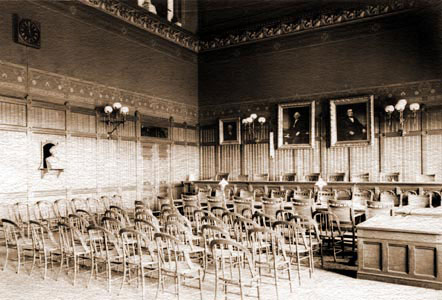
Almost always, the cases heard in the Supreme Court have first been decided in the Superior Court, which is a trial court where a judge or a jury makes a decision based on conflicting stories from witnesses who describe the history of the controversy. The losing party in the Superior Court has the right to one appeal to another court. Most of these appeals go first to the Appellate Court, Connecticut’s intermediate court of appeals.
Appeals come to the Supreme Court in one of two ways. A person who is dissatisfied with the judgment of the Appellate Court can ask the Supreme Court to take another look at the legal issues that are at stake, by filing a request that the appeal be certified. Other appeals come to the Supreme Court as a result of a decision to transfer the case to itself instead of having it be heard in the Appellate Court, or as a result of a law mandating that an appeal must be heard by the Supreme Court. For example, appeals involving reapportionment of voting districts and death penalty cases are always heard in the Supreme Court. After an appeal has been taken, each party files a brief and the court then schedules the case for oral argument at the next available session of the court.
If you listen to an oral argument at an appellate-level court such as the Supreme Court, you will notice that it differs from an oral argument in the trial court. In the trial court, the lawyer is addressing a jury of lay persons or a judge, urging the jury or judge to make certain findings of fact. In the Supreme Court, the lawyer is addressing a panel of justices, urging them to reach certain conclusions of law.
Before the oral argument, each justice has already carefully studied the written briefs that present each party’s legal arguments, as well as the factual and procedural history of the case. The justices therefore ask many questions in order to understand fully the positions being advanced by each party. Although the justices sometimes ask about the facts, the dialogue between the lawyers and the court centers on issues of law. The justices expect the lawyers to know how the present case fits in with other cases that the court has decided in the past and with statutes that the legislature has adopted. The justices may also inquire into the possible effect that a ruling in this case may have on related factual situations that may arise in the future. Experienced lawyers welcome this dialogue as the best way to win a close case. They know that oral argument may change the justices’ views of who should prevail on appeal or of why a particular party should prevail.
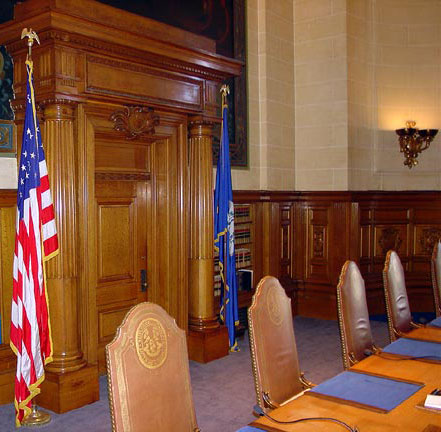
The court hears three or four different cases on each day on which oral arguments are scheduled. After the oral arguments have been finished, the court meets, in its conference room, to reach a preliminary decision about the outcome of each case. When the justices disagree, the greater number becomes the majority of the court on that case. After all the cases in each session of the court have been heard and discussed, the Chief Justice assigns each case to one of the justices in the majority to prepare a draft opinion.
For each of his or her assigned cases, the justice reads the record of earlier proceedings and researches the law of Connecticut and often of other states, as well. Preparing a draft opinion takes time because it requires careful analysis of the law and the facts and preparation of a persuasive written document for the court and the parties. Sometimes, work on a draft opinion persuades the justice that the case should have a different outcome than that voted at the initial conference. In that event, the case will be discussed again at another court conference. The court may then vote to change the outcome.
Once the proposed outcome of a case is finally determined, a draft opinion is prepared and circulated for extensive comments by the other justices who heard the case. A justice who agrees with the outcome, but not with the analysis of the majority opinion, writes a separate concurring opinion. A justice who disagrees with the outcome, in whole or in part, writes a separate dissenting opinion. A final opinion for the court is voted at a court conference after all the opinions have been circulated and agreed upon. The majority opinion and the separate opinions are then sent to the Reporter of Judicial Decisions. The reporter checks the opinions for technical accuracy, and sees to their posting in the Connecticut Law Journal. When the opinions are finalized, the parties receive notification of the result and the opinion is then published on the Judicial Branch website as an Advanced Release Opinion. Within the next two weeks, the opinions are published in the Connecticut Law Journal by the Commission on Official Legal Publications.
A party that disagrees with the judgment of the Supreme Court may file a motion for reargument or for reargument en banc. If that motion is denied, the party can seek permission to file an appeal in the Supreme Court of the United States, but only if the case involves an issue of federal law. On questions of state law, a decision of this court cannot be further appealed. The legislature is always free, however, to change the applicable law within constitutional limits.
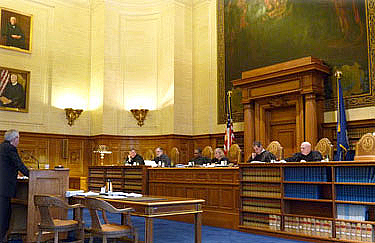
The Supreme Court courtroom is 43 feet wide, 56 feet long and 35 feet high. Most of the wood in the room is oak. The state seal is emblazoned on many of the wall panels, the lamps and the carpet. Included in the seal is the state motto, “Qui transtulit sustinet” (“He who transplanted still sustains”). The portraits on the walls are those of the most recently retired Chief Justices.
The two murals that dominate the room were painted by Albert Herter and placed in the building upon its completion in 1913. Behind the justices’ bench is “The Signing of the Fundamental Orders of 1638-39.” The Orders, the first written constitution in the United States, were drawn up by Thomas Hooker, Roger Ludlow and John Haynes. Hooker is shown standing and addressing the gathering. Ludlow, the secretary, is seated, while Haynes stands in the background with a copy of the new constitution in his hand. In the corners of the mural are the seals of England, seventeenth century Connecticut and modern Connecticut.
The ceiling mural is entitled “An Allegory of Education.” At the top, a mother is seated with the Book of Knowledge and Experience in her lap and her child by her side. On her left stands the Spirit of Wisdom; on her right, the Spirit of Progress. The center portion shows two young men bearing flaming torches that represent the light of education gained from the Book of Knowledge and Experience. They are going forth into life’s activities, urged on by the Spirits of Wisdom and Progress. The bottom portion of the mural shows two figures, representing ignorance and superstition. They appear confused as they fall farther and farther into the darkness as the light of education advances.
